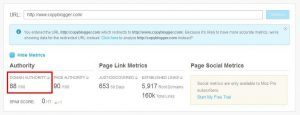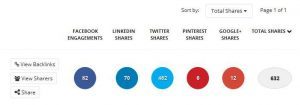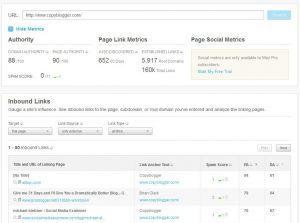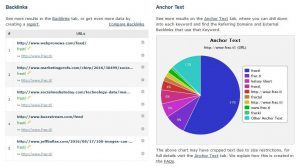You feel a sense of excitement when your brand or story is featured on a website. It feels like a big victory. You’ve succeeded in getting digital PR and spreading your content marketing campaign.
But then what?
You can’t just look at a link or mention and consider it a win. You must measure and track your placements so you can see the results and impact of your work. To do that effectively, you need to know two things: (1) what to measure and track, and (2) how to measure and track those metrics.
The rest of this post will explain how to monitor, review, track, and organize your brand mentions and links so you can measure the results of your digital marketing and PR efforts.
Part 1: What to Measure and Track
At Fractl, we use several metrics to measure the results of a brand mention or link. We track down each pickup and classify them by the following factors. This allows us to get a big-picture view of the success of each campaign rather than just listing an aggregate number of pickups.
Not all pickups are created equal, so it’s important that you have this granular breakdown to have accurate reporting.
Type of Mention
When your brand is mentioned on another website, you first need to look at what type of placement it is. Categorize the mention as one of the following:
- Dofollow Link: The mention includes a link that leads back to your website and passes SEO value and authority to your website. This is the most valuable type of mention.
- Nofollow Link: The mention includes a link that leads back to your website, but the link does not pass SEO value and authority to your website. Nofollow links include a line of code that blocks value from passing through the link. (Learn how to tell if a link is a dofollow or nofollow.)
- Co-Citation: The mention refers and links to a third-party article that mentions your brand or story.
- Text Attribution: Your brand and story are mentioned, but there is no link back to your website.
- Needs Attribution: Your story or details of the story (such as images, data, etc.) are mentioned, but there is no mention of your brand or link back to your site. This is the least valuable mention, and it is considered a form of online plagiarism.
When your brand or story is mentioned on a website, assign one of these categories to the type of placement. Put the highest value on a dofollow link.
Put the least amount of value on a mention that needs attribution. We actually recommend reaching out to these websites and asking them to update the story with proper attribution. This will help you get more value out of the mention.
Value of Link
Once you know what type of mention you have, you should then assign a value to your links. To find the value of the link, look at the linking website’s Domain Authority (DA).
Domain Authority is a metric from Moz that is the “best prediction for how a website will perform in search engine rankings.” A score is a number between one and 100. The higher the number, the better the authority of the website is.
Use the DA metric as a number of “points” that you assign to each of your links and mentions. The total number of points will help you measure the value of each placement.
Social Shares and Comments
In addition to where your content is featured, you also want to track the performance of each placement. You need to consider the amount of audience engagement for the post.
Measure the number of Facebook, LinkedIn, Twitter, and Google+ shares. Track the total number of shares and the total number of comments as well. These numbers will grow as posts with your placements go live. Set a timeframe to review the results to see how the numbers change.
Number of Impressions
Another way to measure the audience engagement of a placement is by looking at the number of impressions or page views the article received. While you likely won’t be able to get the exact number of page views for a third-party website, you can get a good idea by using tools that estimate website traffic.
There are other metrics you can also use to measure content marketing success. Fractl has even created a user-friendly ROI calculator that allows you to input campaign cost, traffic, social shares, links gained, and major placements.
But the number of dofollow links, DA points, and the number of social shares will be the most helpful metrics in measuring the value of placements secured during content marketing.
Part 2: How to Measure and Track
Knowing which metrics to measure is only half of the job when determining the value of your placements and content marketing results. You also need to know how to measure and track those metrics.
Set Up a Report
The first thing you need to do is put all of your content placement tracking in one place. Set up a spreadsheet or custom dashboard for your data.
A spreadsheet is a simple way to track all of your placements and metrics. You can also create custom dashboards that automatically pull in a variety of metrics for each placement, such as social shares and backlinks. (This is what we do at Fractl.)
Whichever method you choose, create a database that includes the following information for each placement:
- Publisher (Include the link to the main website that mentioned your brand or story)
- Story Link (Include the exact URL that mentioned your brand or story)
- Type of Mention
- Domain Authority of Publisher
- Facebook Shares
- LinkedIn Shares
- Twitter Shares
- Google+ Shares
- Total Number of Shares
- Total Number of Comments
- Number of Page Views
Set up reports so you can see the metrics for each link. And prepare the data so you can review total metrics for the campaign as a whole.
These data will give you a good look at which placements were the most valuable (which may direct your future efforts) and help you put a value on your overall campaign (which will allow you to compare your campaign results with the other campaigns you run).
Use Tools to Monitor and Measure
Before you can measure and track mentions, you need to know that the placements exist. So part of your process must include plans for monitoring brand mentions and backlinks, as well as other important metrics. There are a few tools that can help with this process.
Google Alerts (for monitoring brand mentions)
Google Alerts will notify you via email any time one of your defined keywords is mentioned online. You set the keywords (such as your brand name or keywords from your campaign) that you want to be notified about, and Google will alert you each time those words are published on a webpage.
With Google Alerts, you can not only set up branded keywords to track, but you can also track any mention of your URL to get alerted when you have new backlinks.
BuzzSumo (for monitoring brand mentions, backlinks, and the number of social shares)
BuzzSumo offers many useful tools in one platform. They have BuzzSumo Content Alerts, which works a lot like Google Alerts. You set up keyword alerts, and BuzzSumo notifies you via email when your keyword, author, or domain are mentioned online.
BuzzSumo provides reports on all of the backlinks pointing to your main site or a specific URL. The paid version of BuzzSumo will provide a report on all inbound links.
BuzzSumo also offers a tool for finding the total number of social shares for a piece of content. You enter the page URL and BuzzSumo reports the specific number of shares on certain social platforms, as well as the total number of social shares. The unpaid version allows for a few free searches per day.
Moz Open Site Explorer (for finding a website’s DA and monitoring backlinks)
The Moz Open Site Explorer is valuable for two reasons. First, you can use the tool to find the Domain Authority of a website. Enter the main URL of a publisher who mentioned your brand or story, and you can find the DA ranking.
You can also use the tool to monitor the links leading to your website. When you enter your website’s URL, you will receive a report on your website’s inbound links. The paid version offers a full report on every link, along with the linking page’s DA, which makes it a great tool for quickly pulling metrics. To get the full report on your backlinks, you’ll need the paid version.
Majestic Site Explorer (for monitoring backlinks and anchor text)
Another backlink reporting tool is the Majestic Site Explorer. The tool provides data on all of your backlinks and the anchor text of those links, which is useful for seeing how other publishers are referring to your brand or story when they link back to you.
Alexa (for finding page views on third-party websites)
To find the number of views for a webpage on a third-party website, you can use Alexa. Alexa provides information on a site’s estimated number of page views. The data are provided for paid versions of their tool only.
Quantcast (for finding page views on third-party websites)
Another way to check on the number of page views for a website is by using Quantcast. Quantcast provides page view information for select, high-authority websites. Not all websites are included in their database, but you may be able to use the tool to pull information on more well-known websites.
Each of these tools makes it easier for you to measure and track mentions and links for your brand. Using these tactics and receiving a notification of a placement will be exciting. It’s a win for your content marketing campaign.
And now you will know how big of a win it really is.
By using these strategies and assigning values to your digital placements, you can measure the true results and impact of each of your brand mentions and links.
Take a look at how we use these metrics and tracking strategies to measure the value of our content marketing campaigns in this roundup of 10 Case Studies That Show the Real Impact of Content Marketing. Or contact us today to see how we can use these strategies to create effective digital marketing campaigns and detailed reports on their results for you.












